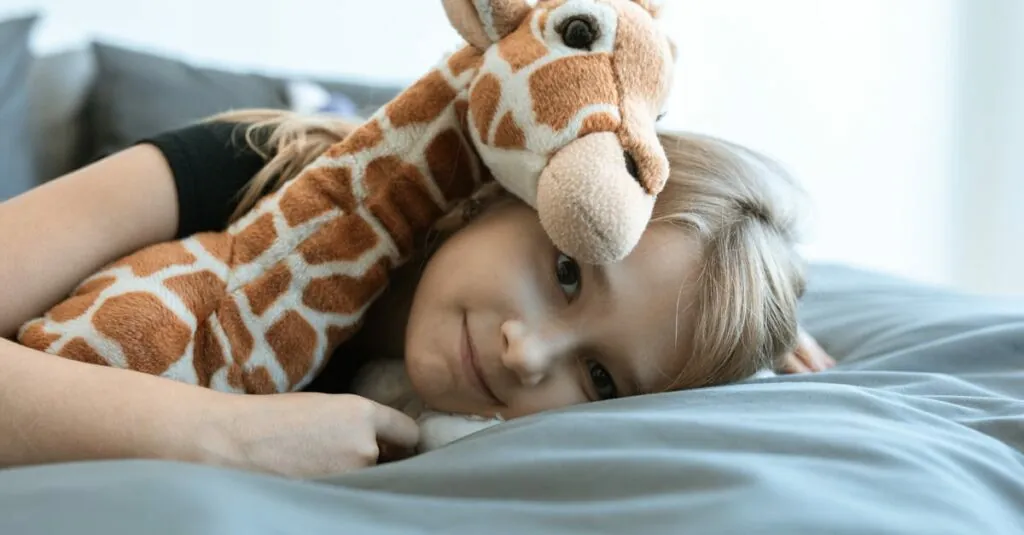When it comes to babies and sleep, things can get a bit wild. Ever heard of active sleep? It’s that quirky phase where your little one seems to be in a dreamland marathon, kicking and twitching like they’re training for the baby Olympics. This fascinating sleep stage is crucial for their development, but it can leave parents scratching their heads and wondering if their baby is auditioning for a role in a horror movie.
Table of Contents
ToggleWhat Is Active Sleep In Babies?
Active sleep, also known as REM (Rapid Eye Movement) sleep, plays a critical role in a baby’s growth and brain development. During this sleep stage, it’s common for babies to exhibit rapid movements like twitching, kicking, and facial expressions, which may appear startling to parents. These movements indicate heightened brain activity, essential for cognitive functioning.
Babies spend approximately 50% of their sleep in active sleep, especially in the first months of life. This duration decreases as they grow, leading to a balanced sleep cycle involving both active and quiet sleep. Parents often notice that these episodes can occur at any time during the night or nap time.
During active sleep, a baby’s heart rate and breathing can fluctuate. Such variations may cause concern among parents, but they’re a normal part of this sleep stage. Babies learn to process their experiences and emotions while dreaming, which fosters emotional development.
Researchers emphasize that active sleep contributes to memory consolidation and learning. By engaging in this vital sleep phase, babies enhance neural connections, promoting intelligence and skills. Newborns may awaken briefly during or after an active sleep episode, often leading to feeding or comforting needs.
Observing a baby in active sleep can be fascinating. The rhythmic movements and occasional smiles may signal pleasant dreams. While active sleep can perplex parents, understanding its significance aids in appreciating the remarkable processes occurring during a baby’s rest.
Characteristics Of Active Sleep
Active sleep in babies shows distinct features that reveal insights into their developmental processes. Notably, two key characteristics define this sleep phase: eye movement and body movements.
Eye Movement
During active sleep, rapid eye movements frequently occur behind closed eyelids. These movements signify intense brain activity, reflecting the engagement of neurological development. Babies might appear to be dreaming, which plays a role in shaping their early experiences. Researchers note these eye movements as an indicator of cognitive processes, assisting in memory formation and emotional processing. Parents may observe darting movements that can last from a few seconds to a minute, showcasing the brain’s active engagement with sensory stimuli.
Body Movements
Infants experience various body movements during active sleep. Kicking, twitching, and facial grimacing commonly surface, indicating, the body’s response to dreams or internal sensations. This behavior signifies critical brain activity linked to neural connections. Babies often exhibit rhythmic patterns, sometimes resembling playful movements. Such motions help with physical development, enhancing muscle tone and coordination. Additionally, the periodic nature of these movements can reassure parents that their child is healthy and actively processing information. Observing these characteristic movements provides insights into the fascinating world of a baby’s sleep patterns.
Importance Of Active Sleep
Active sleep plays a crucial role in a baby’s early life. It significantly supports essential developmental processes necessary for healthy growth.
Brain Development
During active sleep, brain activity increases, fostering important neural connections. Rapid eye movements indicate engagement in cognitive development and dreaming, which may help shape a baby’s early experiences. This stage contributes to memory consolidation and learning, essential aspects of cognitive function. Research suggests that about 50% of a baby’s sleep consists of this phase during the initial months of life. Enhanced brain activity during these cycles supports overall intelligence and skill development.
Growth And Healing
Active sleep serves as a vital period for growth and healing in babies. The body undergoes significant restoration while sleeping, aiding in physical development. Growth hormone release occurs predominantly during sleep, particularly in this active phase. Nutrients are utilized more effectively, promoting cellular repair and healthy growth. Additionally, this sleep phase assists in processing experiences, which supports emotional healing and overall well-being. Engaging in active sleep allows babies to build strength and resilience, underpinning their growth journey.
Differences Between Active Sleep And Other Sleep Stages
Active sleep contrasts sharply with other sleep stages. This phase is characterized by rapid eye movement and significant bodily activity.
Quiet Sleep
Quiet sleep, also known as non-REM sleep, differs fundamentally from active sleep. During this stage, babies experience restful periods with slow and steady breathing. Movements are minimal, and eye activity is absent. Brain activity slows, promoting physical recovery and growth. Babies in quiet sleep may rest soundly, allowing for consolidation of memories and essential rejuvenation. It typically constitutes the remaining 50% of a baby’s sleep in their early life, alternating with periods of active sleep. Parents may notice a stillness that suggests deep tranquility, indicating a crucial aspect of healthy sleep patterns.
Wakefulness
Wakefulness occurs between sleep cycles, representing an important part of a baby’s daily rhythm. Babies demonstrate alertness and interaction during these moments. Eye contact, cooing, or fussiness may signal their needs, highlighting communication development. These brief episodes often lead to feeding or changing needs, ensuring babies receive appropriate care and attention. Wakefulness also provides opportunities for social interaction, stimulating cognitive growth. Observing slight changes in behavior signals distinct shifts between sleep and wakefulness, showcasing a baby’s emerging personality and responsiveness to the environment.
Tips For Parents
Understanding active sleep in babies helps parents navigate this fascinating sleep phase. Recognizing its signs can ease concerns and enhance parenting.
Recognizing Active Sleep
Parents can identify active sleep through specific behaviors like rapid eye movements, kicking, or twitching. Observing these movements indicates a baby is in a crucial development stage. Brief awakenings may occur during this phase, usually followed by feeding or soothing needs. Understanding these patterns reduces anxiety, as movements reflect healthy brain activity. Parents notice smiles or facial expressions, suggesting delightful dreams, which adds to the joy of watching a baby sleep. Embracing these signs helps parents appreciate the remarkable growth taking place during active sleep.
Creating A Sleep-Friendly Environment
Creating a conducive sleep environment significantly enhances a baby’s sleep quality. Maintaining a calm, dimly lit room encourages relaxation and comfort. Utilizing white noise machines helps mask background sounds that might startle a baby awake. Establishing a consistent sleep routine fosters a sense of security and predictability. Parents benefit from dressing their baby in breathable fabrics to prevent overheating during sleep. Ensuring a safe sleep surface free from clutter promotes both comfort and safety. Creating this peaceful atmosphere supports uninterrupted active sleep, allowing for optimal development.
Active sleep in babies is a fascinating and essential phase that significantly contributes to their growth and development. Understanding this stage helps parents appreciate the remarkable processes happening while their little ones rest. The rhythmic movements and occasional smiles during active sleep not only indicate brain activity but also reflect emotional and cognitive development.
By recognizing the importance of this sleep phase, parents can better support their baby’s needs and create a nurturing environment that fosters healthy growth. Embracing the wonder of active sleep allows parents to witness their child’s journey toward cognitive and emotional resilience, enhancing the overall parenting experience.





